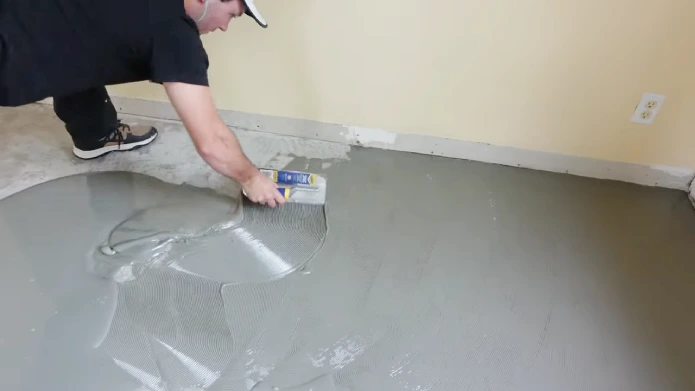Concrete floors are a great choice for residential and commercial properties due to their sturdy, long-lasting nature. However, they are not impervious to the damage that moisture can cause. Moisture seeping through cracks or pores in a concrete floor can lead to mold growth, discoloration, and cracking, making it less durable.
Sealing the concrete floor from moisture is crucial for preserving its appearance and longevity. The process of sealing your concrete floor involves several steps, including preparing and repairing the floor, testing for moisture, and finally, adding the sealer.
Get ready to learn all about protecting your concrete floor from moisture. We’ll break down each step and give you some helpful tips so you can seal it up like a pro.
How to Seal Concrete Floor from Moisture: Steps By Step
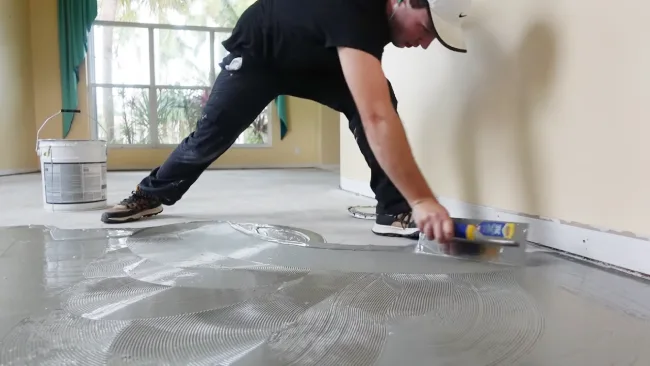
Don’t let moisture ruin your concrete floor. Sealing it can keep it looking great and strong, but it can be tricky if you’re not sure how. Here’s how to do it right:
Step One: Preparing Your Concrete Floor For Sealing
Preparing Your Concrete Floor for Sealing can be tedious, but protecting your flooring from moisture is necessary.
To start preparing your concrete floor for sealing, thoroughly clean the surface. Any dirt or debris on the floor will prevent proper adhesion of sealants. You can use a pressure washer or a scrub brush with soap and water to ensure no residue is left behind.
After cleaning, allow sufficient drying time before proceeding with any further steps.
Step Two: Repairing Cracks And Holes
One common problem that arises is the formation of cracks and holes due to constant exposure to water or high humidity levels. These can cause serious damage if left untreated, leading to costly repairs.
An appropriate filler material must be chosen based on the size and depth of the crack or hole. This could include epoxy resin, cementitious grout, or polyurethane sealant.
After applying the filler, it’s important to let it dry completely before sealing and waterproofing.
Step Three: Testing For Moisture
After repairing any cracks and holes in your concrete floor, take measures to prevent moisture from seeping in.
Testing for moisture levels in your concrete floor ensures successful sealing. Various methods are available for testing moisture content, such as using a calcium chloride test kit or measuring humidity levels within the concrete slab with specialized equipment.
Step Four: Choosing The Right Sealer For Your Concrete Floor
You should choose a high-quality concrete sealer appropriate for your situation. One factor to consider when choosing a sealer is whether you want a penetrating or topical sealer.
Penetrating sealers enter the concrete pores while maintaining breathability, allowing moisture vapor transmission out of the slab. Topical sealers form an impermeable barrier on top of the concrete that repels water but can trap any existing moisture within.
Consider how much foot traffic your space gets and if you need slip resistance. Another factor to contemplate is what kind of finish you desire. Acrylic sealers come in gloss, semi-gloss, and matte finishes offering excellent abrasion resistance. However, they tend to yellow over time due to UV exposure.
Epoxy coatings offer high chemical resistance and durability but can be slippery when wet unless broadcasted with an anti-slip aggregate. Polyurethane coatings provide exceptional abrasion resistance and are highly resistant to chemicals and yellowing under UV light.
Step Five: Applying The Sealer To Your Concrete Floor
Once you have chosen the right sealer, it’s time to apply it. Always follow the manufacturer’s instructions for best results and safety.
Apply the sealer with a brush, roller, or sprayer, depending on the product and surface area’s size. Apply an even coat across the entire floor and use multiple coats if needed. Allow adequate drying time between each application.
What are the Benefits of Sealing Your Concrete Floor?
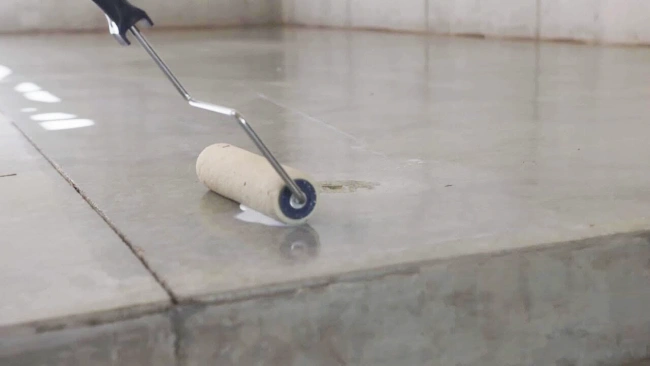
Before diving in and using your concrete floor, take a second to understand the advantages of sealing it. Sealing reinforces your floor and safeguards it from pesky water and moisture damage.
1. Protection from Moisture
Exposure to moisture can be detrimental to concrete floors, causing damage and deterioration over time. Protecting your concrete floor from moisture is a crucial benefit of sealing it. By sealing the surface, you prevent cat urine, water, and other liquids from penetrating into the pores of the concrete, which can cause damage or discoloration.
2. Increased Durability
Another benefit of sealing your concrete floor is increased durability. Concrete floors are exposed to heavy foot traffic, harsh chemicals, and other forms of wear and tear that can cause damage over time.
Sealing the surface creates a protective layer that shields the concrete from these factors, preventing it from becoming brittle or cracked. Epoxy coatings are an excellent choice for increasing the durability of your concrete floor.
They create a strong bond with the surface, making it more resistant to impact and abrasion. This coating also protects against chemical spills and stains, which can be particularly useful in industrial settings where hazardous materials are often handled.
3. Improved Aesthetics
It is also beneficial to seal your concrete floor to improve its aesthetics. Untreated concrete floors can appear dull and unappealing, but applying a sealant or coating can enhance their visual appeal.
One popular choice for improving the appearance of concrete floors is acid staining. This process involves applying an acidic solution that reacts with the minerals in the concrete to produce variegated color tones. The result is a mottled surface that resembles natural stone or marble.
Acid staining can be used on indoor and outdoor surfaces, creating a durable finish that resists fading.
Another option for enhancing the look of your sealed concrete floor is using colored sealers or coatings. These products contain pigments that add color depth and vibrancy to the surface while protecting against damage and stains.
Finding a color sealer to match your decor or brand identity is easy if you’re using them commercially.
Causes of Moisture in Concrete Floors and Preventions
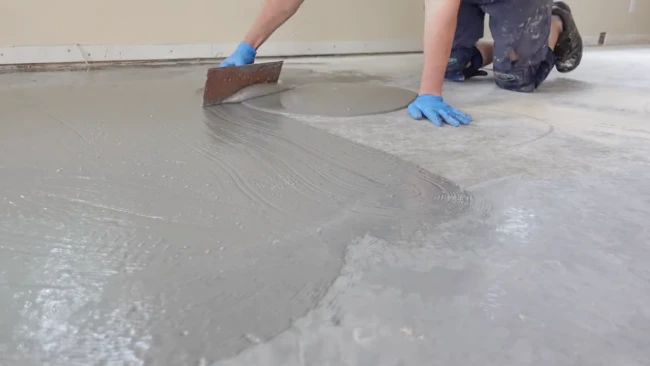
Believe it or not, some common reasons for moisture buildup exist. Luckily, by learning about these culprits, you can take action to fix any problems you already have.
ONE: Water Leaks
Water leaks can be a major cause of moisture in concrete floors. The thought of water seeping into your home and damaging the foundation, walls, or flooring can evoke fear and anxiety in any homeowner. Water leaks happen for many reasons, like faulty plumbing, damaged roofs, floods, heavy rainfalls, and more.
When there is excess moisture present in concrete floors due to water leaks, it can lead to several issues. The prolonged presence of water on the surface can weaken the floor’s structural integrity by causing cracks and fissures. This not only affects the appearance but also reduces its lifespan.
To prevent water leaks from worsening, homeowners should identify the source of the leak before sealing their concrete floors. Once identified, they should consult an expert for guidance on whether repairs are necessary before proceeding with sealant applications.
TWO: Poor Drainage
Another common cause of moisture in concrete floors is poor drainage. Poor drainage occurs when the water has no proper path to drain away from the surface, leading to standing water on top of the floor.
This can occur due to various reasons, such as inadequate grading, clogged gutters and downspouts, or improper installation of drainage systems.
When there is poor drainage present in concrete floors, it can lead to several issues, including cracks, fissures and mold growth. Water on the floor causes cracks and fissures that weaken its structural integrity.
To prevent poor drainage from causing further damage, homeowners must first identify its source before taking any corrective actions. Consult an expert to see whether repairs are necessary before enhancing their drainage systems through installations like French drains trenches or sump pumps.
THREE: High Humidity
High humidity can also be a cause of concrete floor moisture. When humidity levels are too high, the air around the floor is humid and can cause condensation to form on its surface. This results in moisture buildup that weakens floors’ structural integrity.
The prolonged presence of moisture can also lead to further issues like mold growth. The first step is finding the source of high humidity to prevent further damage. If you’ve spotted humidity in your home, a dehumidifier or air leak sealing can be a simple solution.
What are the Signs Your Concrete Floor Needs to be Resealed?
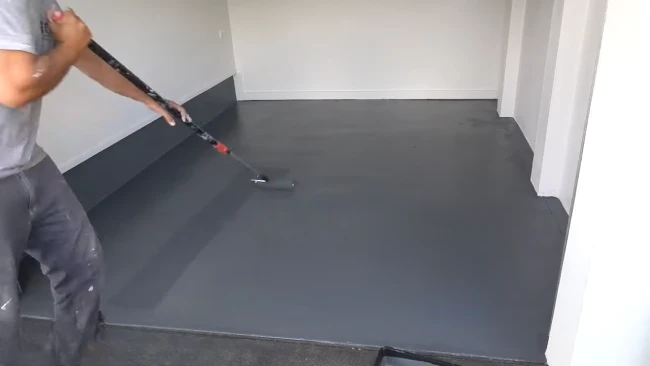
Resolving your concrete floor to maintain strength and integrity periodically is important. But how do you know when it’s time for a reapplication? Check out these signs that your concrete floor needs resealing.
One: Discoloration
The discoloration is one of the most common signs that your concrete floor needs resealing. This can happen for various reasons, including exposure to water and chemicals, UV rays from sunlight, or general wear and tear. The discoloration may appear as dark spots or patches on the surface of the concrete floor.
If left untreated, discoloration can further damage the concrete floor by weakening its structure and causing it to crack or crumble over time. Discolored floors may also have an unpleasant odor due to mold growth caused by moisture buildup under the surface.
Therefore, taking immediate action is essential when you notice any sign of discoloration on your concrete floor.
Two: Cracking
Another sign of concrete resealing is cracking. Cracking occurs when the concrete loses its strength and begins to break apart due to various factors such as weather changes, heavy traffic, or structural issues.
These cracks may appear small initially but can quickly grow in size and depth if not addressed immediately. Cracks on a concrete floor can be hazardous, especially for people who frequently walk or drive over them. The broken surface can cause tripping hazards, vehicle damage, or even injury.
Three: Staining
In addition to cracking, discoloration or staining is another sign it needs resealing. Over time, the porous nature of concrete can cause it to absorb various substances such as oil, grease, and chemicals.
These substances penetrate deep into the surface of the flooring, causing unsightly stains and affecting its overall appearance. Due to slippery surfaces, chemical spills on unsealed concrete floors may release harmful fumes or cause slip-and-fall accidents.
Are concrete surfaces capable of being sealed to prevent sweating?
Concrete surfaces can be sealed to prevent sweating by using a combination of a penetrating sealer and a concrete densifier. Sealing the concrete with a penetrating sealer prevents moisture from entering the surface and causing sweating.
Using a concrete densifier as a primer beforehand aids in preventing moisture penetration and strengthens the concrete surface. It is important to note that a properly sealed concrete surface will prevent sweating and protect the surface from potential damage caused by moisture infiltration.
Using a high-quality penetrating water repellent in addition to a densifier ensures the best possible outcome and provides optimal protection against moisture damage. A professional concrete sealing service can help prevent concrete from sweating long-term.
Is it a good idea to seal old concrete?
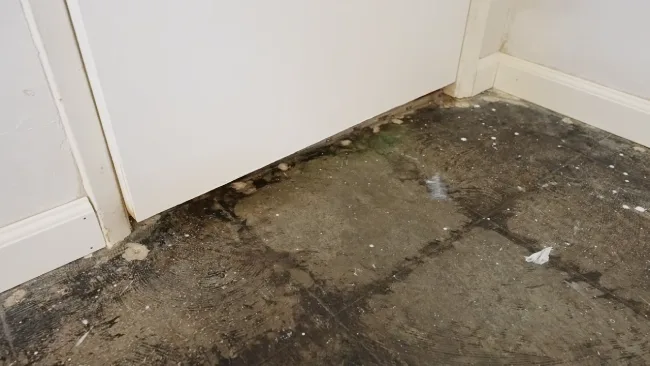
It is highly recommended to seal old concrete to ensure its longevity and visual appeal since concrete performs well only if it’s never sealed. A good quality sealer application every few years can significantly extend the life of old concrete while maintaining its overall aesthetic.
The sealer acts as a protective coat against external elements such as water, UV rays, and chemicals that can damage or erode concrete over time. Additionally, the sealer can enhance the texture and color of the concrete, making it more visually appealing and resistant to stains.
By investing in a professional concrete sealer, property owners can rest assured that their old concrete surfaces are well-protected and will stand the test of time.
Does it matter how much sealer you use on concrete?
It is crucial to apply the appropriate amount of sealer to concrete surfaces. Overapplication can result in the formation of bubbles on the surface, as the air displaced through the concrete is trapped. This occurs irrespective of the weather conditions during application and can lead to an unsightly and uneven appearance.
Furthermore, it is important to note that the porosity level of the concrete surface affects the amount of sealer required. And as a consequence, applying too much sealer to non-porous concrete might result in a “milky” or cloudy appearance, which could be unsightly.
In contrast, too little sealer will negatively affect the durability and longevity of the concrete surface since it won’t be adequately protected from possible damage caused by exposure to the elements. So, applying the proper amount of sealer is important, considering factors like porosity and environmental conditions.
Seal Your Concrete Floor to Prolong its Lifespan
Moisture in concrete floors is a common problem that gets worse over time. Sealing your concrete floor from moisture offers numerous benefits, such as prolonging its lifespan and preventing the growth of mold and mildew.
However, choosing the right sealer and properly preparing your floor are crucial steps to ensure effective sealing.
Sealed concrete floors provide excellent protection against moisture but are not completely immune to damage. As with any construction material, regular maintenance is required to keep your concrete floor in optimal condition.
By following best practices for application and conducting routine inspections, you can help prevent costly repairs down the road.
